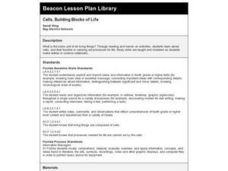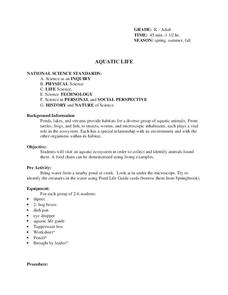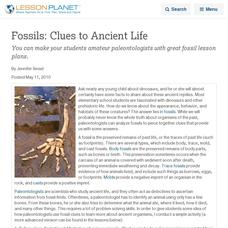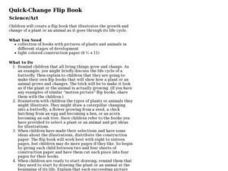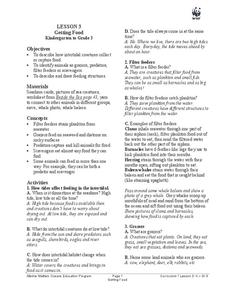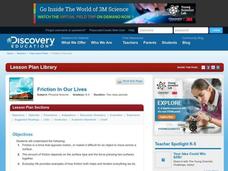Curated OER
Cells, Building Blocks of Life
Fourth graders, in groups, explore cells, the basic unit of all living things.
Curated OER
Aquatic Life
Students explore aquatic life. For this science lesson, students visit an aquatic ecosystem and collect animals found there. Students create a food chain for the aquatic ecosystem.
Curated OER
Reading: Living in Space
In this living in space reading worksheet, students read a passage about life on the International Space Station written by a former astronaut. Students then answer 6 multiple choice questions.
Curated OER
A Social Science Lesson for Grades 4-7
Students become more knowledgeable about the lives and responsibilities of circus kids and become aware of diverse family lifestyles.
Curated OER
Trout Life-Cycle Booklet
Students write books about trout, completing one page per life stage.
Curated OER
What Do We Mean by "Living Things"?
Students discuss the characteristics of life. In this living things instructional activity students complete a lab while working in groups. Students examine different organisms and create a poster to present to the class.
Curated OER
Butterfly Life Cycles
Students study the butterfly life cycle. In this interdisciplinary life cycles instructional activity, students study the life cycle of a butterfly, their migration habits, and the culture of the region in Mexico where butterflies...
Curated OER
Living in a Watershed
Fourth graders examine watersheds. In this ecosystem lesson, 4th graders discover what a watershed is and identify the local watershed they live in. Students investigate the attributes of a watershed as well.
Curated OER
Colonial Life
In this colonial life worksheet, students read a 1 page article on colonial life, make a Venn diagram that shows how life for colonial children was different from and similar to theirs and discuss what part of colonial life they liked...
Curated OER
Water: H2O = Life
In this earth science worksheet, students explore and describe animals and their adaptations, including their habitats, physical characteristics, and competing organisms. They also explore and describe how others use water around the...
Curated OER
Life in a Drop of Water
Students observe the wealth of living organisms in a drop of water from our freshwater ecosystems. They classify the types of organisms observed as single-celled or multi-cellular and use a key or chart to identify and name the organisms...
Curated OER
Through the Eyes of an Owl
Students describe vertebrates in terms of observable body parts and characteristics and describe life cycles of familiar organisms. They identify familiar organisms as part of a food chain or food web and describe their feeding...
Curated OER
Draw an Alien in Natural Habitat
Students apply prior knowledge of living things, structures of living things and how living things sense and respond to their environment. In this habitat instructional activity, students review the basic needs of organisms to survive....
Curated OER
Fossils: Clues to Ancient Life
You can make your students amateur paleontologists with great fossil lesson plans.
Curated OER
Building A Bug Bungalow
Students chart how milkweed bugs grow and change. In this growth and life stages lesson, students read two stories and discuss how and why things grow. Students brainstorm what can be measured about humans, review and discuss...
Curated OER
Quick-Change Flip Book
Students create flip books that illustrate the growth and change of a plant or an animal as it goes through its life cycle.
Curated OER
Marine Life, Oceans, Lakes and Rivers
Students examine the types of organisms found in oceans. In groups, they read articles about the research done at certain sites. They work together to research their own water ecosystems and report the findings to the class. To end...
Curated OER
Getting Food
Learners complete activities to learn about the ocean food web. In this ocean life lesson, students discuss how the tides affect feeding, learn about filter feeders, grazers, predators, and scavengers. Learners then group the animals...
Curated OER
Friction in Our Lives
Students explore force and friction. In this force and friction lesson, students discover everyday examples of how friction helps and hinders things we do. Students create a ramp to test the speed of their car. Students use...
Curated OER
How Big is Big?
The blue whale is the focus of this life science worksheet. Learners read an excellent selection on the blue whale, and answer ten comprehension questions. Then, students are divided into two groups. Each group has to estimate how big 85...
Curated OER
Horseshoe Crab Fun
Marine biology masters will meet the horseshoe crab and red knot shore birds that feast upon the crab eggs. Begin with a discussion and then have learners write postcards from each animal detailing their migration trips. A few math...
Curated OER
Life Cycles in the Rain Forest Research
In this life cycles in the rain forest research worksheet, students use reference materials and the Internet to collect information about the life cycles of animals that live in the rain forest. They fill in the name of the animal and...
National Wildlife Federation
Box Turtle Interview
Imagine life as a box turtle. Learners study the characteristics of box turtles and then assume the role in an interview. They show their understanding of how a box turtle lives by responding to a series of questions.
Curated OER
The Intertidal Zone: Tide and How Creatures Survive
Learners explore oceanography by completing science worksheets. In this tide pools lesson, students discuss the forces of the tide pools, the animals that live within them, and the impact they have on the rest of the ocean. Learners...
